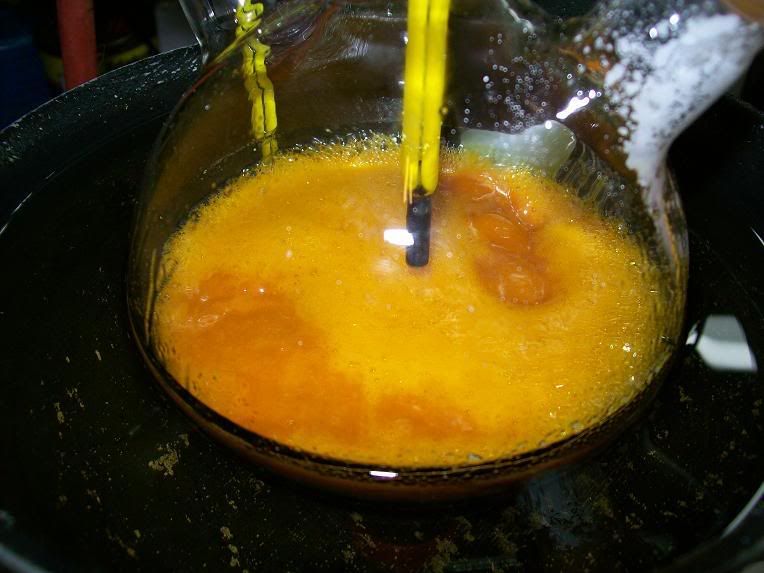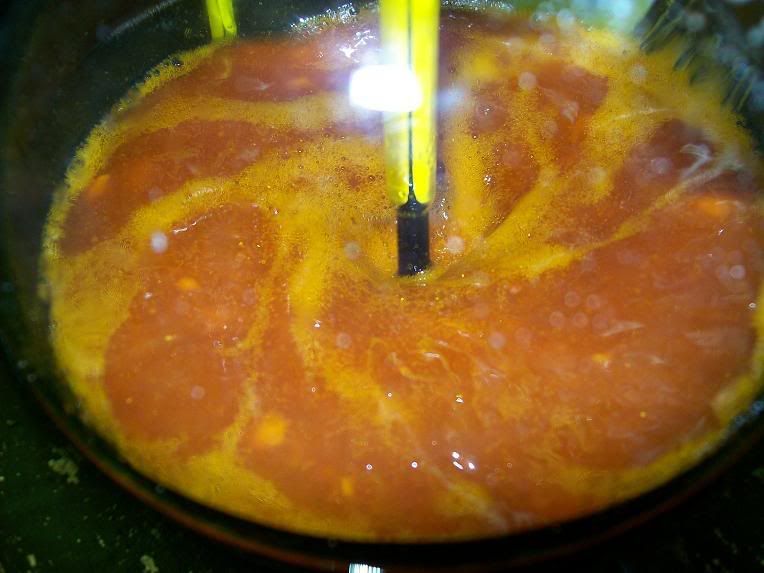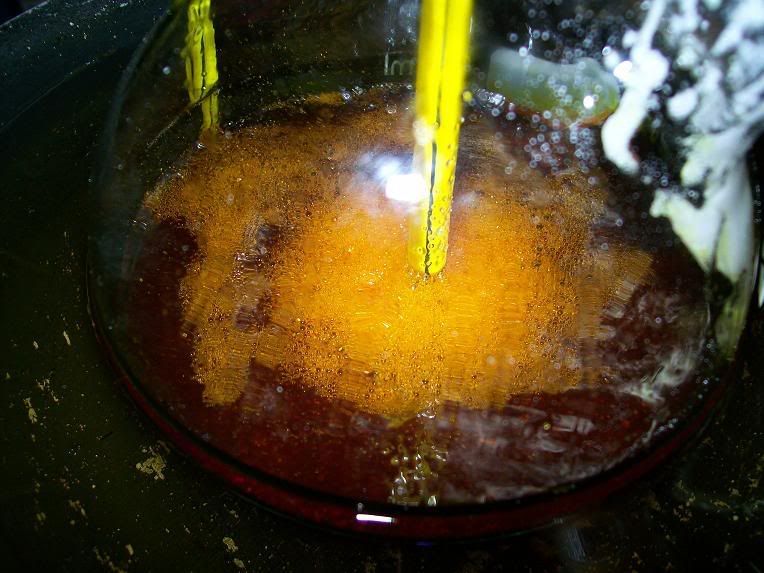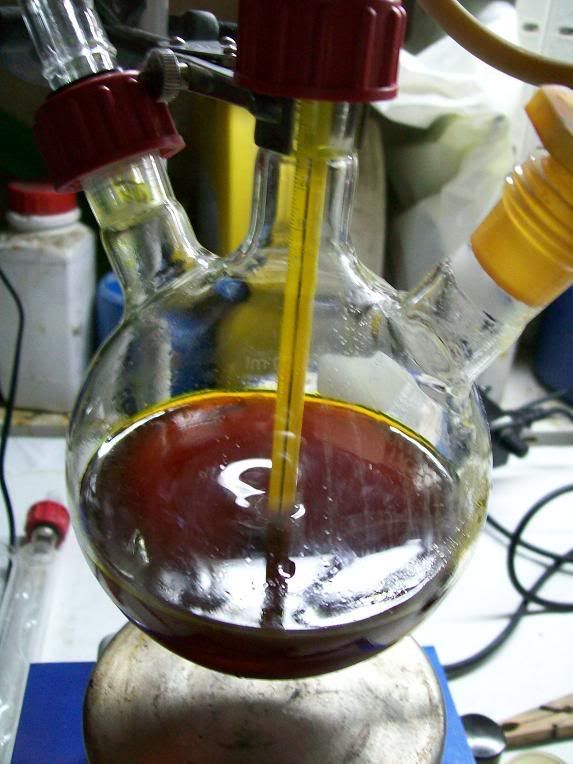Klute
International Hazard
    
Posts: 1378
Registered: 18-10-2006
Location: France
Member Is Offline
Mood: No Mood
|
|
Mg-mediated o-formylation of phenols: A Writeup
Introduction
Hydroxyarylaldehydes are valuable intermediates in organic chemistry, being building blocks for numerous ligands in coordination chemistry
amongst other uses.
Introduction of a formyl group (-CHO) opens the doors to a plethora of reaction pathways, but often requires dangerous reagents, or affords low
yields of impure products.
O-formylation of phenols by the well-known Riemmer Tiemann process, using chloroform in presence of alkali hydroxides suffers from numerous
drawbacks, such as low yields and excessive tar formation.
In J. Chem. Soc. Perkin Trans.; 1 (1994) 1823-31 , R. Aldred et al propose a efficient procedure of formylating
magnesium bis-(phenoxide) salts, generated by reacting the phenolic substrate with magnesium methoxide, in high yield with dry paraformaldehyde as
source of anhydrous formaldehyde. Similar procedures employ MgCl2/Et3N [1], or other combinations of metal chlorides and amines, to generate the
phenolate before reacting it with paraformaldehdye [2].
This procedure was tried out as it uses cheaper and more accessible reagents. Previous experimentations demonstrated that the reaction was high
yielding, and although a little long, a very promising and rewarding way of o-formylating phenols.
Experimental: O-Formylation of phenol
Phenol, paraformaldehyde and magnesium powder were obtained from Panreac. The phenol was dried for 3 days over CaCl2, the paraformaldehyde powder
was dried for 3 days over P2O5, the Mg was kept under argon.
Toluene and methanol came from freshly opened bottles, and were dried over 3A molecular sieves for 3 days without any distillation.
All the glassware was oven-dried at 150°C for 1H and left to cool after being purged with argon.
Preparation of magnesium methoxide
In a 500mL 3-neck RBF equipped with: an reflux condenser mounted with a freshly-fused CaCl2 guard, an addition funnel mounted with a gas inlet, a
rubber septum and magnetic stirring, were introduced 40mL of anhydrous MeOH via syringe.
3.65g (150 mmol) of Mg powder were weighed out and placed in a vial. 1/3 of the Mg powder were introduced in the flask via a solid addition
funnel, under a slow stream of argon, followed by a crystal of I2 (1). The flask was slowly heated with a hair dryer, until the yellow color
started fading away and H2 evolution started. As the flask warmed up, it was immersed in a RT (10°C) oil bath. Vigorous H2 evolution started.
After 15min, the reaction had come to a halt as all the mg was dissolved, giving a gel-like sludge. The rest of the Mg was added, and heating
started. After 20min reflux, a thick magnesium methoxide sludge was obtained (2), the oil bath was removed.
Preparation of magnesium bis-(phenoxide) salt
23.53g (250 mmol) of >99% phenol were placed in a 250mL schlenk. The schlenk was evacuated for 5min while shaking the solid to remove any
remaining humidity. It was then purged with argon, and the operations renewed another 2 times. The rubber stopper was replaced by a septum under a
flow of argon, and 140mL anhydrous toluene added via syringe. The schlenk was warmed up with a mantle to achieve complete dissolution, giving a
totally clear solution. This solution was charged into the addition funnel with an oven-dried canula, using slight argon over-pressure. It was then
added the methoxide in a small stream, with steady stirring. A dark emeraude green/blue solution was obtained (3), and the flask immersed in
a 75°c oil bath.
After 10min reflux, a white solid started precipitating, giving a white suspension that gradually thickened to a thick slurry of the phenolate.
Reflux was maintained for 30min total.
The condenser was quickly replaced, under a stream of argon, with a dry simple distn setup, and the MeOH/toluene azeotrope removed ( ~60°C vapor
temp) until the pot temp increased from 70°C to 90°C, over 30min. 70mL of a clear distillate was obtained.
Formylation of the magnesium bis-(phenoxide)
23.12g (770 mmol) of paraformaldehyde powder was weighed and cut in two portions (4). A spatula was added via solid addition funnel,
immediately causing a yellow color to appear, the slurry thinning up. The distillate take-off increased noticeably after the additions. The addition
was continued in portions, adding 2-3 spatula every 5-10min, the internal temperature being kept at 95-98°C. The color gradually darkened, giving an
opaque orange suspension. When half the paraformaldehdye had been added (40min), the suspension cleared up giving a limpid orange solution, with large
white phenolate chunks in suspension (5). A certain amount of solid was stuck to the sides of the flask, so it was scrapped off using a dry
spatula tip.
As the addition proceeded, all the solids dissolved nicely, giving a dark red limpid solution. Heating had to be diminished as the amount of
methanol present decreased. The addition took 1H30 total, and the flask was left to stir at 95°c for another 30 min. A total of 130mL distillate was
obtained, with a slow take off during the whole addition (1drop/1-3 secs). The flask was then cooled to 30°C.
Workup
200mL of 14% H2SO4 was prepared (283 mmol) by diluting 75mL of 37% H2SO4 to 200mL with dH2O, and added to the flask with good stirring. After a few
seconds, the dark red organic layer turned yellow, then green, then yellow again over 5 min. It was left to stir for 15min total (6), then
transferred to a 1L separating funnel. The layers were separated, and the aqueous extracted with 50 + 2x25mL toluene. The first wash was dark orange,
the other two very light brown/beige.
The combined organics were washed with 150mL 5% H2SO4, 2x150mL dH2O (final pH= 5), and 200mL brine. All the washes came out totally clear. The
orange organics (300mL) were then dried over Na2SO4 for 15min. A TLC (eluant: DCM) indicated 2 minor impurities other than the product, but no
unreacted phenol, as well as a small uneluted spot.
The extract was transferred to a 500mL RBF, fitted with a simple distn setup, and the toluene removed under slight vacuum, at 70-75°C. Near the
end of the distillation, the distillate was slightly colored (7). Vacuum was increased near the end, and a dark brown "oily" colored residue
was obtained. The flask was cooled down, and the residue transferred to a 100mL RBF, using a little distilled toluene to rinse the flask.
The RBF was fitted with a vacuum distn setup, using a cow receiver, but no column (8). The toluene was removed at full vacuum, and heating
gradually increased until a green/yellow oil started passing at 135°C. The product was collected between 135-155°C because of a problematic vacuum
(fluctuations of pressure), to give 25.07g (205.29 mmol) of 2-hydroxybenzaldehyde, or salicylaldehyde, in a 82.11% yield
(9), single spot by TLC (DCM, and 10% DCM
in pet ether). IR spectrum will be taken ASAP.
Notes
(1): If all the magnesium is added at once, a very violent reaction occurs and some MeOH is lost through the ice-cold condenser. Adding
it in portions is more advisable. Using coarser magnesium could avoid this.
(2) If heating is left for too long, a cake of magnesium methoxide is obtained, which is unpractical for the next step, as it requires
scratching off the solid to able proper stirring.
(3) I'm not sure was this color is due to. In any case the formation of the phenolate isn't immediate, as it takes at least 5 min of
reflux to see the first white solid appearing.
(4) This was done to avoid excessive humidity absorption, as the atmosphere of the lab was pretty humid.
(5) this always happens when half the paraformalehdye is added. Not sure what causes this, maybe enough insoluble unformylated phenolate
as been consumed to afford a clear solution at this point, the formylated magnesium phenolate being soluble in toluene.
(6) A lot of procedures call for letting the acidified mixture to stir for several hours. Once stirring was left for 2hours, only to
discover a thick polymeric sludge, impossible to filter to recover any product. Excess formaldehyde caused formation of phenol-formol polymers with
the product under such conditions.
(7) A column should be used for better separation.
(8) The vacuum pump (compressor) seemed to have problems, and afforded an unstable vacuum, so only a rough distillation was conducted. A
vigreux would have been used with a proper, stable vacuum source.
(9) More product was recovered from the distillation setup (very viscous) by distilling acetone through it. Curiously, it turned orange
directly upon contacting acetone. This also ables to remove the tarry residue in the flask.
Pictures
Reflux setup:

Initiation of the magnesium methoxide formation with I2:

Vigorous H2 evolution:

Mg(OCH3)2 sludge:

Phenol in schlenk:

Adding the phenol solution into the addition funnel via canula:

Dark green/blue solution obtained after adding the phenol:

Refluxing during formation of the phenolate:

Slurry of the white magnesium bis-(phenoxide) salt:

Distn setup:

Color change after adding the first spatula of paraformaldehyde:

20 min into addition:

Half-way through the addition, once the suspension becomes limpid:

At the end of the addition:

The cooled mixture:

Just after adding the acid:

Green color appearing a minute after:

Yellow color coming back after another minute:

Washed organic layer:

Organic extract drying over Na2SO4:

Distn of the toluene:

Crude product:

Vacuum distn of the crude product:

Distilled product:

Pur salicylaldehyde:

References:
[1] "Convenient method for the ortho-formylation of phenols" N.U. Hofslokken, L. Skattebol Acta Chem. Scand. 53
(1999) 258-262
Also see: US5260487; US6274068;
[2] JCS Perkins I, (1980) 1862-1865; US4151201; etc....
|
|
|
guy
National Hazard
   
Posts: 982
Registered: 14-4-2004
Location: California, USA
Member Is Offline
Mood: Catalytic!
|
|
Nice work. Now if you find ethylenediamine, or any 1,2 diamine, you can make salen derivatives!
And Im wondering: you have a schlenk line in your house??
also, how did your TEMPO synth go?
[Edited on 3/12/2008 by guy]
|
|
|
Klute
International Hazard
    
Posts: 1378
Registered: 18-10-2006
Location: France
Member Is Offline
Mood: No Mood
|
|
That is exactly what I plan to do with (part of) it!  There a lot of nice
complexes to form, notably all the paramagnetic Fe salen complexes. I aslo want to make some saltrien, although I need to get my hands on some
triethylenetetramine... There a lot of nice
complexes to form, notably all the paramagnetic Fe salen complexes. I aslo want to make some saltrien, although I need to get my hands on some
triethylenetetramine...
Aslo salicylaldoxime, although Iw ill surely try the direct formaldoximation, adding hydroxylamine at the end of the addition of the PA. Just to get
those nicely colored complexes!
Beleive it or not, the triacetoneamine is still forming in it's bottle. 
It's been over 6 month I think! it doesn't change in colour anymore. I really should vacuum distill it soon.....
for the schlenk, I simply use a Argon line, and a seperate on for the vacuum. Swapping between both is a little clumpsy, but most of the time the few
ppm of oxygene absorbed when changing tubing isn't problematic with the syntheses I conduct.. I would love to have a manifold, I migth enherit a old
one that isn't used anymore at work, when they get a new one to replace it.
[Edited on 13-3-2008 by Klute]
[Edited on 13-3-2008 by Klute]
|
|
|
len1
National Hazard
   
Posts: 595
Registered: 1-3-2007
Member Is Offline
Mood: NZ 1 (goal) - Italy 1 (dive)
|
|
Very nice - if I can make a few comments - just my preferences really.
I would prefer a theory section - just so you can tell at the beginning what is going to happen later on. I know I can figure it out from reading the
entire article - but one often has to decide quickly if something is of interest to oneself.
I would have preferred pictures indespersed with the text - that makes it easier to follow (and they would have to be smaller)
Otherwise great stuff!
|
|
|
Klute
International Hazard
    
Posts: 1378
Registered: 18-10-2006
Location: France
Member Is Offline
Mood: No Mood
|
|
Thank you for the comments. Yes, it is true I should have detailed the theory briefly before. To be honest, I had this reaction on my mind for a week
before, so it just came out naturally  I haven't provided the article either,
which isn't very respectfull for people that haven't heard of this reaction before. I haven't provided the article either,
which isn't very respectfull for people that haven't heard of this reaction before.
In some other posts, I placed the pictures into the text, as they occured in the procedure. I thought that it "broke" the description a bit, as one
would rather focus of the pictures. I considered that after reading the procedure, and being able to recall the different steps, it would be more
clear to reconize the differents parts displayed.
I would also like to put diminished icons instead of the photos, so they take less place and we could always click on them to see the large picture.
Unfortunaly my computer skills are limited to the basic minium, and I don't know how to do that. AS stupid as I am, I've just read the picture thread
in forum matters, so I ahve no escuse. I will try to repair that with some moderators...
Initially, this was a "regular" post in the Org. Chem. forum. I was invited to transfert it here, which I did without modifying the layout/content,
what I should have done, but it was late.
And of course, as you know, it is impossible to modify your posts after 24h..... But I will keep your comments in mind for a eventual subsequent
thread.
EDIT: I'm attaching the article discussed above.
Thanks you for your critizism.
[Edited on 14-3-2008 by Klute]
Attachment: Magnesium-mediated.pdf (1.3MB)
This file has been downloaded 3028 times
|
|
|
Ullmann
Hazard to Self
 
Posts: 51
Registered: 22-12-2004
Member Is Offline
Mood: No Mood
|
|
Thank you for this very detailed work, Klute
|
|
|
Klute
International Hazard
    
Posts: 1378
Registered: 18-10-2006
Location: France
Member Is Offline
Mood: No Mood
|
|
My pleasure!
\"You can battle with a demon, you can embrace a demon; what the hell can you do with a fucking spiritual computer?\"
-Alice Parr
|
|
|
kclo4
National Hazard
   
Posts: 916
Registered: 11-12-2004
Location:
Member Is Offline
Mood: No Mood
|
|
This does really look like a great method, but does magnesium need to be used? I assume things like calcium, and whatever would work but how about
aluminum? Aluminium is cheaper, and its not to hard to turn into its methoxide from my understanding. I don't see why it wouldn't work for this, but
many of you know and can see much more then I can about this reaction.
I may be over looking something, such as whatever is in the references, since I can't seem to view many of them.
|
|
|
Arrhenius
Hazard to Others
  
Posts: 282
Registered: 17-8-2008
Location: US & A
Member Is Offline
Mood: Stochastic
|
|
Magnesium methoxide appears to work particularly well in that it's chelating. The paper suggests a reaction mechanism and intermediate which involve
a chelated phenolate salt. It is also important that the reaction be anhydrous, and in the preparation of magnesium methoxide, the methanol is made
extremely dry. Aluminum exists in several oxidation states, and calcium is less available than magnesium. Why not use magnesium?....
|
|
|
kclo4
National Hazard
   
Posts: 916
Registered: 11-12-2004
Location:
Member Is Offline
Mood: No Mood
|
|
I don't have any magnesium and didn't want to order any, but I guess it is probably about time that I do..
I have aluminum however, so that is why I was wondering. I was saying that calcium would probably work as well, but was wondering about other metals..
such as aluminum.
|
|
|
DJF90
International Hazard
    
Posts: 2266
Registered: 15-12-2007
Location: At the bench
Member Is Offline
Mood: No Mood
|
|
kclo4: I suggest the purchase of some magnesium powder/turnings - It will be useful not just for this reaction but also for the formation of grignard
reagents. I'll attach the paper I have on this for your viewing pleasure 
Attachment: Mg mediated o-formylation.pdf (1.3MB)
This file has been downloaded 4513 times
Attachment: Orgsyn Mg mediated o-formylation.pdf (64kB)
This file has been downloaded 6031 times
|
|
|
kclo4
National Hazard
   
Posts: 916
Registered: 11-12-2004
Location:
Member Is Offline
Mood: No Mood
|
|
Thank you for the articles.
I guess it is time I buy some Mg, if anyone wants to PM me a cheap source go for it. I've found a few, but the cheapest seems to be firefox.fx, but I
don't know if they are good since one of my friends has had recent problems ordering from them.
|
|
|
Klute
International Hazard
    
Posts: 1378
Registered: 18-10-2006
Location: France
Member Is Offline
Mood: No Mood
|
|
I would also recommend getting some Magnesium. It is not all sure aluminium will work the same...
\"You can battle with a demon, you can embrace a demon; what the hell can you do with a fucking spiritual computer?\"
-Alice Parr
|
|
|
497
National Hazard
   
Posts: 778
Registered: 6-10-2007
Member Is Offline
Mood: HSbF6
|
|
Would it be possible to use trioxane in the reaction instead of paraformaldehyde?
|
|
|
UnintentionalChaos
International Hazard
    
Posts: 1454
Registered: 9-12-2006
Location: Mars
Member Is Offline
Mood: Nucleophilic
|
|
It's generally not nearly as reactive as paraformaldehyde, so no. However, take a look at this paper if you'd like:
Attachment: Trioxane-Formaldehyde.pdf (487kB)
This file has been downloaded 1552 times
Department of Redundancy Department - Now with paperwork!
'In organic synthesis, we call decomposition products "crap", however this is not a IUPAC approved nomenclature.' -Nicodem
|
|
|
Paddywhacker
Hazard to Others
  
Posts: 478
Registered: 28-2-2009
Member Is Offline
Mood: No Mood
|
|
Zinc powder is somewhat easier to obtain than magnesium powder. Is it possible to get zinc powder to form a methoxide?
And would the zinc phenate salt work with this reaction in the same way as the magnesium salt?
|
|
|
JohnWW
International Hazard
    
Posts: 2849
Registered: 27-7-2004
Location: New Zealand
Member Is Offline
Mood: No Mood
|
|
No; Zn, like Al, or at least the pure metal, forms an impervious oxide layer on its surface on exposure to air or to polar liquids in which oxygen can
dissolve, which unlike that formed by Mg (slowly soluble) is insoluble in pH-neutral water. In the case of Zn and Al, the necessary reactivity would
occur only under conditions in which this oxide layer is continually removed, such as by dissolution with strong acid or alkali (which however are
likely to also react with alcohols), or by formation of a liquid alloy (amalgam) with Hg or Ga (but Ga would probably also react slowly with
alcohols).
Ca, which has to be stored dry and away from oxygen, would readily form a methoxide and ethoxide, though, by reaction with the alcohols. However, it
is too electropositive to react with alkyl or aryl halides to form compounds like the Grignard reagents with a Metal-C covalent bond, being more
likely to abstract the halogen atoms to form a dihalide, with dimerization as an hydrocarbon of the organic halide.
[Edited on 7-11-09 by JohnWW]
|
|
|
DJF90
International Hazard
    
Posts: 2266
Registered: 15-12-2007
Location: At the bench
Member Is Offline
Mood: No Mood
|
|
You COULD form zinc methoxide from the metal powder, on the condition that you add a small quantity of HgCl2 or the like to amalgamate the metal (as
in the case of aluminium). Whether the zinc phenoxide that you would subsequently form reacts analogously to the magnesium phenoxide is anyones guess;
you'd have to try it and see.
|
|
|
Nicodem
Super Moderator
      
Posts: 4230
Registered: 28-12-2004
Member Is Offline
Mood: No Mood
|
|
An example of the MgCl2/Et3N/MeCN variation of the Mg-directed ortho-formylation method with paraformaldehyde
(originally reported in Acta Chem. Scand., 53, 258-262) is now reported also on the Synthetic Pages (on 4-tert-butylphenol):
o-formylation of 4-tert-butylphenol; 5-tert-butyl-2-hydroxybenzaldehyde
…there is a human touch of the cultist “believer” in every theorist that he must struggle against as being
unworthy of the scientist. Some of the greatest men of science have publicly repudiated a theory which earlier they hotly defended. In this lies their
scientific temper, not in the scientific defense of the theory. - Weston La Barre (Ghost Dance, 1972)
Read the The ScienceMadness Guidelines!
|
|
|